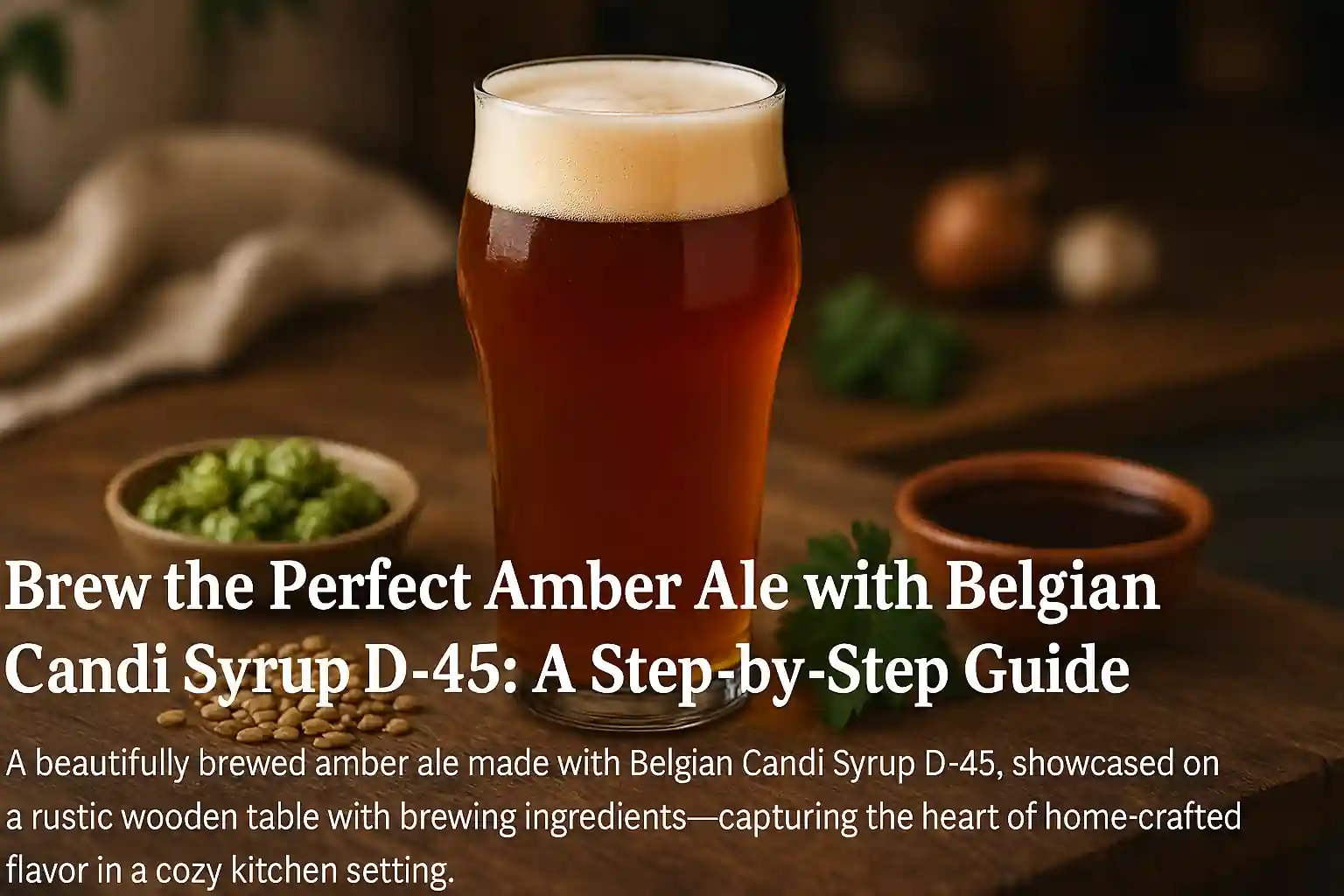Amber Ale Recipe with Amber Candi Syrup D-45
Brewing your own amber ale at home is a rewarding experience, especially when incorporating unique ingredients like amber candi syrup D-45. This style—rooted in the rich traditions of Belgian and American amber ales—produces a beer with deep caramel tones, balanced hop bitterness, and a warm, malty body. This comprehensive guide will walk you through every step to create a well-balanced amber syrup ale, using traditional brewing equipment, fermentables, and flavor-enhancing additions.
The Allure of Ale
Ale has been a cornerstone of beer brewing since antiquity. Distinct from lager, ales are fermented with top-fermenting yeast at warmer temperatures, contributing to bold flavor profiles with esters and complex aromas.
What Makes Amber Ale Unique?
An amber ale typically features a moderate ABV (Alcohol By Volume), balanced hops, and a rich malt backbone with hints of caramel and roasted notes. Styles include American amber ale, known for its crisp bitterness, and Belgian amber, known for its fruity and spicy complexity from the yeast.
Candi Syrup: A Belgian Treasure
Understanding Candi Syrup in Brewing
Candi syrup, especially D-45, is an inverted sugar syrup commonly used in Belgian ales. It’s made by caramelizing beet sugar, resulting in deep flavors and color contributions to beer. Candi syrups are crucial in creating dubbel, trappist ale, and other Belgian dark strong ales.
Learn more about candi syrup and its brewing applications from the American Homebrewers Association.
Brew Ingredients: Building the Amber Ale
Key Ingredients for a 5-Gallon Batch
| Ingredient | Quantity | Purpose |
|---|---|---|
| Pale Ale Malt | 9 lbs | Base malt |
| Munich Malt | 1.5 lbs | Malty backbone |
| Crystal 60L | 1 lb | Caramel flavor and color |
| Amber Candi Syrup D-45 | 1 lb | Flavor, color, fermentables |
| Hop (Centennial or Cascade) | 1 oz @ 60 min | Bitterness (bittering hop) |
| Hop (Willamette) | 1 oz @ 15 min | Aroma |
| Ale Yeast (Belgian or English) | 1 packet | Fermentation agent |
OG, FG, and ABV
-
Original Gravity (OG): ~1.060
-
Final Gravity (FG): ~1.012
-
Expected ABV: ~6.3%
-
SRM: ~15–17 (amber to deep amber)
Brewing Belgian Ales: Mash & Boil
The Mash Process
-
Mash Volume with Grains: 3.25 gallons at 152°F for 60 minutes
-
Use a grain bag or mash tun to extract fermentable sugars.
-
Add amber candi syrup D-45 at the end of the mash or during the boil for full flavor integration.
The Boil
-
Boil Volume: 6.5 gallons
-
Boil Duration: 60 minutes
-
Watch for boil-off losses of 0.5–1 gallon.
Add hops according to schedule. Near the end of the boil, add candi syrup D-45 to fully dissolve and caramelize within the wort.
Explore the chemistry of Belgian sugar syrups in homebrewing.
Hop & Aroma Profile
Hop Variety Selection
-
Bittering Hop: Centennial or Magnum
-
Flavor/Aroma Hop: Willamette or Fuggle
These hops complement the sweet, malty base of an amber ale with earthy, citrus, or floral notes.
Aroma Considerations
-
Esters from yeast
-
Caramel and toasted bread from malt
-
Subtle spice from Belgian-style fermentation
Fermentation & Yeast Choices
Primary Fermentation
-
Temp: 66–72°F
-
Duration: 2–3 weeks
-
Use either a Belgian yeast strain (for fruity/spicy notes) or an English ale yeast (for malty smoothness).
Secondary Fermentation (Optional)
-
Improves clarity and flavor profile.
-
Age for 1–2 weeks in carboys or secondary fermenters.
Find yeast characteristics in White Labs yeast profiles.
Belgian Dubbel & Strong Ale Comparisons
The use of D-45 syrup bridges flavor profiles between an American amber ale and a Belgian dubbel. For deeper complexity, you can experiment with:
-
D-90 syrup: darker, raisin and plum flavors
-
D-180 syrup: intense fig and dark caramel
-
Combining D-90 and D-180 results in a robust Belgian dark strong ale
Compare Belgian syrup types and how each affects your final beer.
Amber Ale Recipe Variations
Caramel Amber Ale
Add more Crystal 80L malt and increase D-45 to 1.5 lbs for a sweeter finish. Use lower attenuation yeast to retain residual sugars.
Strong Ale with Higher ABV
Boost pale malt to 11 lbs and raise OG to 1.075. Choose high attenuation yeast and manage co2 levels carefully for carbonation.
Brew Day Tips & Techniques
Brewing Equipment Checklist
-
Mash kettle or brew-in-a-bag setup
-
7+ gallon brew kettle
-
Wort chiller
-
Fermenter (bucket or carboy)
-
Airlock and thermometer
Ensure proper kettle size to prevent overflow during the minutes left in the boil.
Wort Cooling and Pitching Yeast
Rapidly chill the wort to yeast pitching temp (~68°F). Aerate before adding yeast to optimize fermentation.
Storage, Bottling, and Carbonation
-
Carbonation: Add priming sugar during bottling
-
CO2 Target: 2.2–2.5 volumes
-
Age in bottles for 2–3 weeks at 70°F
Track gravity with a hydrometer to verify fermentation is complete before bottling.
View Recipe Summary: American Amber Ale with D-45
This beer recipe, optimized for homebrewers, blends the smooth character of amber ale with the depth of Belgian candi syrup. It delivers:
-
Moderate bitterness (25–30 IBU)
-
Toasted malt and caramel backbone
-
Subtle fruity/spicy aroma from Belgian yeast
-
Beautiful amber hue (SRM ~16)
Homebrew recipe databases often feature similar builds generated by tools like Brewer’s Friend, helping you scale or tweak your ale recipe.
Conclusion: Your First Beer, Your Best Beer
Creating an amber ale with amber candi syrup D-45 is an approachable way to begin brewing amazing beer. Whether you’re making a caramel amber ale, a rich dubbel, or an adventurous trappist-inspired hybrid, this method offers versatility and great flavor.
For a deeper dive into yeast selection, hop characteristics, or equipment upgrades, check out Craft Beer & Brewing’s resource hub.
By mastering this homebrew style, you not only learn how to brew like a pro—you create a craft beer that reflects your personal taste. Cheers to your next glass of handcrafted, full-bodied amber ale.

